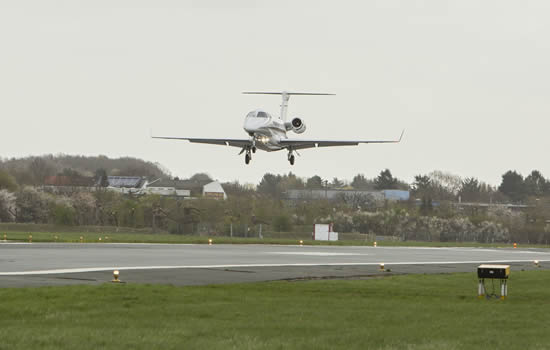|
Bremen Airport, in
the north of Germany, was the setting for a German
first. It
was the first time that a passenger aircraft landed
in Germany using a new satellite-based precision
approach procedure without the aid of the
conventional ground-based navigation infrastructure.
This was made
possible by EGNOS (European Geostationary Navigation
Overlay Service), a satellite-based augmentation
system (SBAS) that supplements GPS and other
satellite navigation systems. It improves the
position accuracy of GPS from 10-20 metres to 1-3
meters. Bremen is the first airport in Germany to
have implemented a precision approach procedure
using SBAS.
SBAS provides an
innovative alternative to the conventional
instrument landing system (ILS) and can also be used
in poor weather conditions. DFS has thus provided
airspace users in Bremen with a workable alternative
to the old system. This is not the first time that
Bremen Airport was on the cutting edge of air
navigation technology. In 2012, the world's first
approach using a ground-based augmentation system (GBAS)
for satellite navigation was employed.
 |
|
First
SBAS approach in Germany at Bremen
Airport on 6 April 2017. |
The International
Civil Aviation Organisation ICAO approved the
satellite-based SBAS precision approach procedure,
giving it the name "LPV 200". The procedure can be
implemented in poor visibility for category I (CAT
I) weather conditions, one of three levels of
all-weather operations. The pilot is guided down to
a height of 200 feet above ground, that is about 60
metres, using satellite-based technology that guides
the aeroplane horizontally and vertically. When the
pilot has the runway in sight, it is safe to land.
Up until now, it
has only been possible to guide aircraft to what is
known as the "decision height" by means of
ground-based systems such as ILS or systems such as
GBAS, which supplement the satellite guidance with a
ground-based station. The new SBAS technology offers
clear advantages compared to conventional approach
procedures. In addition to being an extremely
precise alternative to ILS, SBAS does not require
ground infrastructure that is expensive to operate
and requires a lot of maintenance. EGNOS
geostationary satellites supplement GPS signals to
achieve the high degree of precision for the SBAS
procedure. Together, they fulfil the requirements
needed for precision approach procedures and comply
with ICAO standards.
 |
|
Trailblazers in satellite-based
approaches (L to R): Christian
Knuschke (Bremen Airport, Head of
Aviation), Enrico Stumpf-Siering
(DFS Center Bremen, Chief of Section
Airspace, procedures and capacity),
Christian Glock (Netjets, Pilot),
Maurizio Lupi (Netjets, Pilot) and
Andre Biestmann (DFS, Director of
Airspace and ANS Support). |
"In the medium-
and long term, DFS is planning on making more use of
satellite-based navigation for approaches and thus
create an alternative to the traditional ILS
category I," explained
Andre Biestmann,
Director of Airspace and ANS Support at DFS.
Aircraft cockpits
have to be equipped with EGNOS receivers to be able
to receive the satellite signals. A majority of the
NetJets company's aircraft in Europe are already
equipped with this new technology and it was a
NetJets aircraft that conducted this first SBAS
approach in Bremen.
The modern fleet
of NetJets makes the company an important
contributor to aviation innovation. In autumn 2016,
NetJets and DFS tested the latest approach
procedures with GBAS. This project was awarded an
innovation prize by the European Commission in early
March 2017 as part of the Augmented Approaches to
Land project.
Not all aircraft
manufacturers equip their aeroplanes with EGNOS
receivers. DFS believes that incentives will have to
be created so that aircraft can be equipped with
this technology in the long term.
GBAS - another
satellite-based approach procedure in Bremen:
DFS Deutsche Flugsicherung has operated a
ground-based augmentation system (GBAS) at Bremen
Airport since February 2012. This type of approach
procedure also uses the satellite signals of the US
global positioning system (GPS). The ground-based
antennas provide data that improve the precision of
the satellite data and then send this information to
the approaching aircraft. The SBAS procedure does
not use this type of ground-based facility. |

